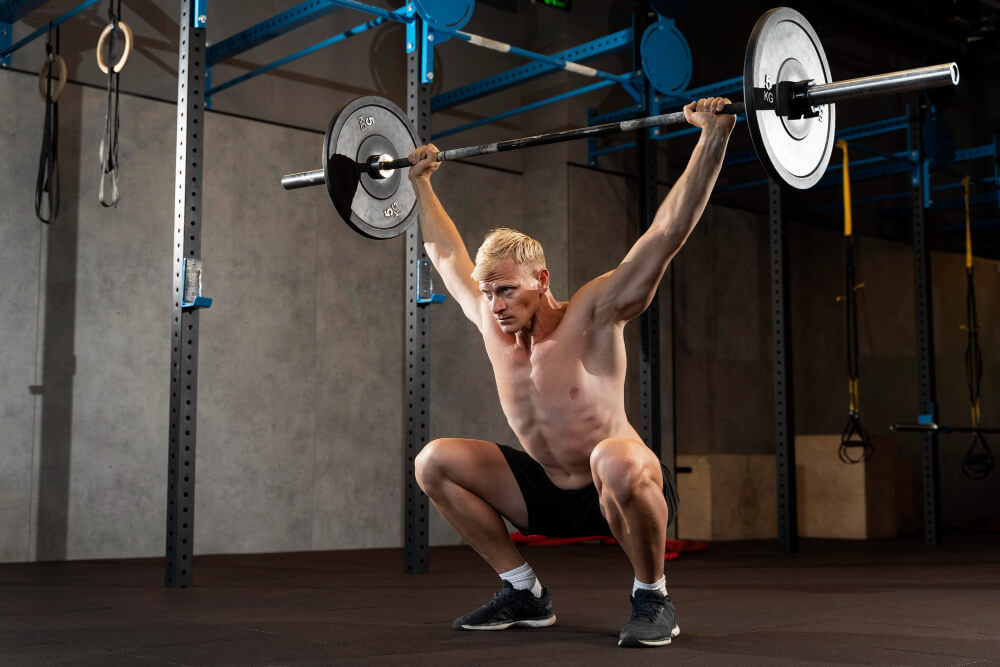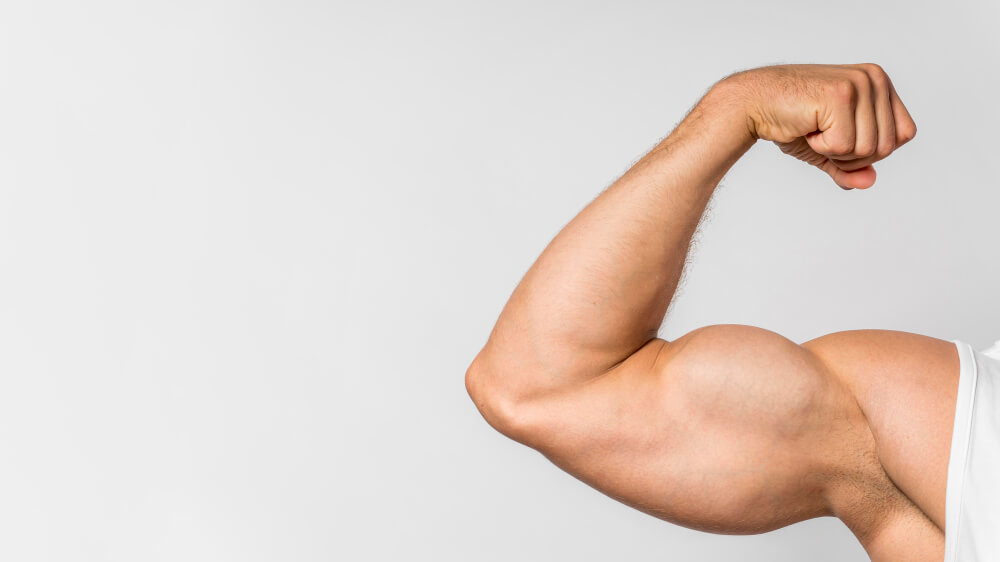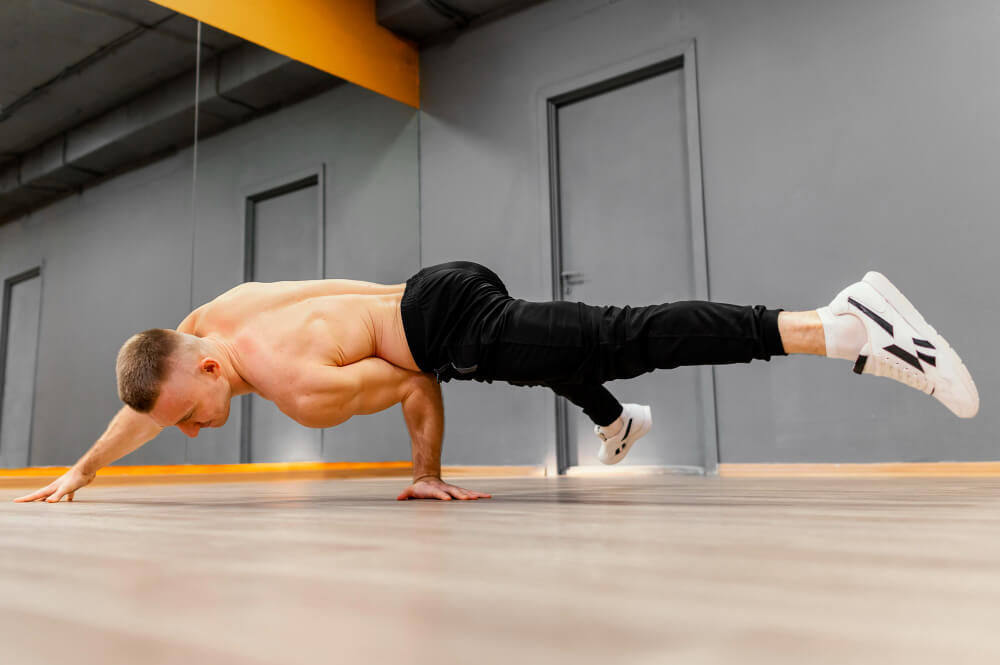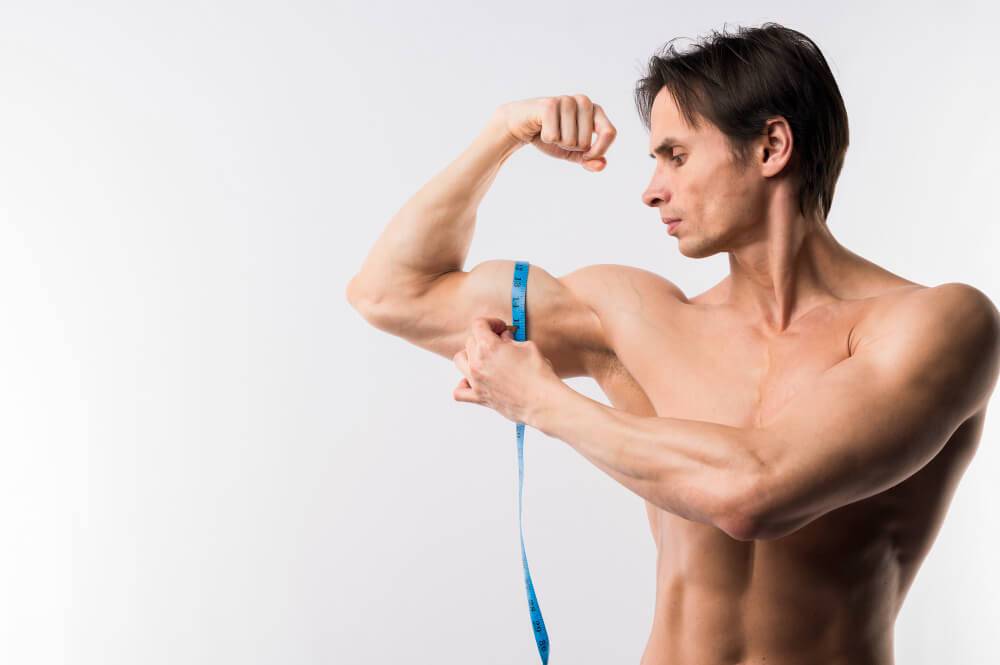When it comes to achieving a well-defined physique, arm definition plays a crucial role. Whether you’re a fitness enthusiast, bodybuilder, or weightlifter, chiselled arms are often a top priority. An arm workout with barbells is an excellent way to achieve this goal.
In this comprehensive guide, we’ll explore the best arm workout with barbells, provide step-by-step instructions, and offer tips for incorporating these exercises into your routine. By the end of this post, you’ll have all the tools you need to master your arm definition.
Arms Anatomy

Before starting the arm workout with brabells, it’s essential to understand the anatomy of the arms. The primary muscles in the arms are the biceps brachii, triceps brachii, and brachialis.
- Biceps Brachii: Located on the front of the upper arm, the biceps Brachii comprises two heads – the long head and the short head. This muscle is responsible for flexing the elbow and rotating the forearm, contributing significantly to arm definition.
- Triceps Brachii: Found on the back of the upper arm, the triceps Brachii has three heads – the long head, lateral head, and medial head. The triceps are crucial for extending the elbow and stabilizing the shoulder joint, making them integral to upper arm strength and aesthetics.
- Brachialis: Positioned underneath the biceps, the brachialis helps flex the elbow. Although it is not as prominent as the biceps or triceps, strengthening the brachialis adds to the overall thickness and definition of the upper arm.
By understanding the function and structure of these muscles, you can better target them during your arm workout with barbells , ensuring you achieve balanced and well-defined arms.
Why Barbell Workouts for Arm Definition?

Barbell workouts are highly effective for arm definition because they allow you to lift heavier weights compared to other equipment, leading to greater muscle growth.
Barbell exercises engage multiple muscle groups simultaneously and promote improved balance and stability. Thus, they are a versatile and powerful component of any arm workout routine.
Muscle Activation and Strength Gains
Barbells are one of the most versatile pieces of equipment in any gym. They allow for a wide range of exercises that simultaneously target various muscle groups. When it comes to arms, barbells provide an unparalleled ability to activate multiple muscles, leading to more balanced and effective strength gains.

For example, you’re not just working your biceps when performing a barbell curl. You’re also engaging your forearms, shoulders, and core to stabilize the movement. This comprehensive muscle activation results in better overall strength and muscle definition.
Progressive Overload for Continued Progress
One key to muscle growth and definition is progressive overload, which involves gradually increasing the weight or resistance used in your exercises. Barbells are perfect for this as they allow you to add weight plates incrementally. This gradual increase challenges your muscles, forcing them to adapt and grow stronger over time.
With barbells, you can easily track your progress and make adjustments to ensure you’re continually pushing your limits. This adaptability makes barbells an essential tool for anyone serious about arm definition and overall strength gains.
Compound Movements for Efficiency
Another significant benefit of using barbells is the ability to perform compound movements. Compound exercises, such as the barbell row or bench press, work multiple muscle groups simultaneously, making your workouts more efficient. This is especially beneficial for those with limited time but still want to achieve maximum results.

Compound movements also promote functional strength, which translates well into everyday activities and other forms of exercise. By incorporating barbell workouts into your routine, you’re not just building muscle but improving your overall physical performance.
Related Articles: Top 9 Medial Head Tricep Exercises For Sculpted And Strong Arms
8 Best Full Arm Workout With Barbell for Defined Arms
Now that we’ve covered the benefits of barbell workouts let’s dive into the eight best barbell arm exercises for arm definition. Each exercise includes step-by-step instructions to ensure you perform them correctly and safely.
Barbell Bicep Curl
The barbell bicep curl is a classic exercise that primarily targets the biceps. It’s an excellent starting point for anyone looking to build arm strength and definition.
How to:
- Stand with your feet shoulder-width apart, holding a barbell with an underhand grip.
- Keep your elbows close to your torso and your back straight.
- Curl the barbell up towards your chest, squeezing your biceps at the top of the movement.
- Slowly lower the barbell back to the starting position.
- Repeat for the desired number of reps.
Mistakes to Avoid:
- Using Momentum: Swinging the barbell or using your hips to lift the weight can reduce the exercise’s effectiveness and increase the risk of injury.
- Elbow Position: Allowing your elbows to drift forward or outward takes the tension off your biceps and can lead to improper form.
- Incomplete Range of Motion: Not fully lowering the barbell back to the starting position or not fully curling it up can limit muscle activation and growth.
- Grip Width: Holding the barbell too wide or too narrow can place unnecessary strain on your wrists and forearms.
By avoiding these common mistakes, you’ll ensure that your barbell bicep curls are both safe and effective, leading to better arm definition and strength gains.
Tips:
- Avoid swinging your body to lift the weight; focus on using your biceps.
- Keep your wrists straight to prevent strain.
Close-Grip Barbell Bench Press
While the bench press is commonly associated with chest workouts, using a close grip shifts the focus to your triceps. This variation is excellent for building tricep strength and definition.
How to:
- Lie on a flat bench with your feet firmly planted on the ground.
- Grip the barbell with your hands shoulder-width apart.
- Lower the barbell slowly to your chest, keeping your elbows close to your body.
- Press the barbell back up to the starting position, fully extending your arms.
- Repeat for the desired number of reps.
Mistakes to Avoid:
- Flared Elbows: Letting your elbows flare out can reduce tricep engagement and increase shoulder strain. Keep your elbows close to your body.
- Arching the back Excessively: Overarching your back to press heavier weights can lead to lower back injuries. Maintain a slight arch in your lower back, keeping it in contact with the bench.
- Partial Range of Motion: Not fully extending your arms at the top of the movement limits tricep activation. Ensure you extend your arms completely.
- Improper Grip Width: Using a grip that is too wide or too narrow can place undue stress on your wrists and shoulders. Stick to a shoulder-width grip for optimal engagement and safety.
By addressing these common mistakes, you can ensure that your close-grip barbell bench press is both safe and effective, resulting in stronger and more defined triceps.
Tips:
- Keep your core engaged throughout the movement to maintain stability.
- Avoid flaring your elbows out to minimize shoulder strain.
Barbell Skull Crushers
Skull crushers, also known as lying tricep extensions, are highly effective for isolating and building the triceps.
How to:
- Lie on a flat bench, holding a barbell with your hands shoulder-width apart.
- Extend your arms straight up, positioning the barbell above your forehead.
- Lower the barbell towards your forehead by bending your elbows.
- Extend your arms back to the starting position.
- Repeat for the desired number of reps.
Mistakes to Avoid:
- Elbow Flaring: Letting your elbows spread out to the sides reduces tricep activation and increases the risk of shoulder strain.
- Barbell Placement: Lowering the barbell too close to your face can lead to accidents; focus on a controlled descent just above your forehead.
- Using Excessive Weight: Lifting too heavy can compromise form and lead to injury. Start with a manageable weight and increase slowly.
- Poor Wrist Alignment: Allowing your wrists to bend can place undue stress on them. Maintain a straight wrist position to minimize strain.
Tips:
- Keep your upper arms stationary and only move your forearms.
- Use a spotter if you’re lifting heavy to ensure safety.
EZ-Bar Preacher Curl
The preacher curl targets the biceps and helps to isolate the muscle for maximum engagement.
How to:
- Sit on a preacher bench and rest your upper arms on the pad.
- Hold an EZ barbell with an underhand grip, shoulder-width apart.
- Curl the barbell towards your shoulders, squeezing your biceps at the top.
- Slowly lower the barbell back to the starting position.
- Repeat for the desired number of reps.
Mistakes to Avoid:
- Lifting the Elbows: Allowing your elbows to lift off the preacher pad reduces bicep isolation and effectiveness.
- Using Excessive Weight: Choosing a weight that’s too heavy can lead to improper form and potential injury. Start with a manageable weight.
- Inconsistent Tempo: Performing the movements too quickly can decrease muscle activation. Maintain a consistent and controlled pace.
- Bending Wrists: Letting your wrists bend can place unnecessary strain on them. Keep your wrists straight throughout the exercise.
Tips:
- Avoid lifting your elbows off the pad to maintain isolation.
- Control the movement to prevent using momentum.
Related Articles: 8 Best Compound Exercises For Chest – Optimal Gains
Barbell Reverse Curl
Reverse curls target the brachialis and brachioradialis muscles, providing a balanced look to your arms.
How to:
- Stand with your feet shoulder-width apart, holding a barbell with an overhand grip.
- Keep your elbows close to your body and your back straight.
- Curl the barbell up towards your chest, keeping your wrists straight.
- Slowly lower the barbell back to the starting position.
- Repeat for the desired number of reps.
Mistakes to Avoid:
- Wrist Curling: Bending your wrists during the lift places unnecessary stress on them. Keep wrists straight.
- Elbows Flaring Out: Allowing your elbows to drift outward reduces the effectiveness of the exercise. Keep elbows close to the body.
- Using Momentum: Swinging the barbell or using your body to lift the weight can compromise form. Perform the movement slowly and with control.
- Neglecting Full Range of Motion: Not fully lowering the barbell limits muscle activation. Lower the barbell completely before starting the next rep.
Tips:
- Focus on keeping your wrists straight to avoid strain.
- Use a lighter weight if needed to maintain proper form.
Barbell Concentration Curl
Concentration curls are excellent for isolating the biceps and ensuring full contraction.
How to:
- Sit on a bench with your legs spread apart.
- Hold a barbell with an underhand grip and rest your elbow on the inside of your thigh.
- Curl the barbell towards your shoulder, squeezing your bicep at the top.
- Slowly lower the barbell back to the starting position.
- Repeat for the desired number of reps, then switch arms.
Mistakes to Avoid:
- Elbow Movement: Allowing your elbow to shift or lift off your thigh reduces bicep isolation and efficiency.
- Using Excessive Weight: Starting with a weight that’s too heavy can lead to poor form and potential injury.
- Incomplete Range of Motion: Not fully extending your arm at the bottom limits muscle activation. Ensure a complete range of motion for each rep.
- Rushed Movements: Performing the exercise too quickly can reduce effectiveness. Focus on controlled and deliberate movements.
Tips:
- Avoid using your body for momentum; focus on using your bicep.
- Control the movement to maximize muscle engagement.
Barbell Wrist Curl
Wrist curls target the forearm muscles and improve grip strength, which is essential for overall arm development.
How to:
- Sit on a bench and rest your forearms on your thighs, holding a barbell with an underhand grip.
- Allow the barbell to roll down to your fingertips.
- Curl the barbell back up to your palms by flexing your wrists.
- Slowly lower the barbell back to the starting position.
- Repeat for the desired number of reps.
Mistakes to Avoid:
- Excessive Weight: Using a weight that’s too heavy compromises form and can cause strain.
- Rapid Movements: Performing the exercise too quickly reduces muscle engagement.
- Limited Range of Motion: Not fully extending or curling the wrist limits effectiveness.
- Poor Wrist Alignment: Letting your wrists bend sideways increases the risk of injury.
Tips:
- Use a lighter weight to ensure proper form.
- Focus on feeling the contraction in your forearms.
Barbell Overhead Tricep Extension
This exercise targets the long head of the triceps and helps to build arm size and definition.
How to:
- Stand with your feet shoulder-width apart, holding a barbell with your hands close together.
- Extend the barbell overhead, keeping your elbows close to your ears.
- Lower the barbell behind your head by bending your elbows.
- Extend your arms back to the starting position.
- Repeat for the desired number of reps.
Mistakes to Avoid:
- Flaring Elbows: Allowing your elbows to move outwards reduces tricep activation and can place unnecessary strain on your shoulders.
- Using Excessive Weight: Choosing a weight that’s too heavy can lead to poor form and potential injury. Start with a manageable weight.
- Arching Your Back: Excessive arching in the back can cause strain and reduce the effectiveness of the exercise. Maintain a neutral spine.
- Incomplete Range of Motion: Not fully extending or lowering the barbell limits muscle engagement. Ensure a complete range of motion for each rep.
Tips:
- Keep your elbows stationary to isolate the triceps.
- Avoid arching your back; engage your core for stability.
Note: In this article, I have told about 8 best arm workout with barbells. If you want to know about more exercises, click here and here.
General Safety Tips
- Warm-Up: Always do a proper warm-up before starting your workout to prepare your muscles and joints.
- Stretch: Incorporate stretching exercises to improve flexibility and prevent injuries.
- Hydrate: Stay hydrated throughout your workout to maintain performance and recovery.
- Rest: Ensure adequate rest between sets and exercises to avoid overexertion.
By following these guidelines, beginners can develop a solid foundation for barbell exercises, ensuring safety and effectiveness in their fitness routines.
Incorporating Barbell Arm Exercises into Your Routine
Now that you know the best barbell arm exercises for biceps and triceps definition, it’s essential to incorporate them effectively into your workout routine. Here’s a sample routine to get you started:
Sample Routine:
Monday:
- Barbell Bicep Curl: 3 sets of 12 reps
- Close-Grip Barbell Bench Press: 3 sets of 10 reps
- Barbell Skull Crushers: 3 sets of 12 reps
Wednesday:
- Barbell Preacher Curl: 3 sets of 12 reps
- Barbell Reverse Curl: 3 sets of 10 reps
- Barbell Concentration Curl: 3 sets of 12 reps
Friday:
- Barbell Wrist Curl: 3 sets of 15 reps
- Barbell Overhead Tricep Extension: 3 sets of 12 reps
Tips for Success:
- Proper Warm-Up:
Always start your workout with a proper warm-up to prepare your muscles and prevent injury.
- Consistency:
Stick to your routine consistently to see the best results. Progress takes time, so be patient and stay committed.
- Rest and Recovery:
Ensure you give your muscles adequate time to recover between workouts. Rest is crucial for muscle growth and overall performance.
Avoid These Mistakes
Even with the best intentions, it’s easy to make mistakes when performing barbell arm exercises. Here are some common pitfalls to watch out for:
Mistake 1: Using Too Much Weight
Using too much weight can compromise your form and lead to injury. Start with a comfortable weight and gradually increase as you gain strength.
Mistake 2: Not Engaging Your Core
Your core plays a crucial role in stabilizing your body during barbell exercises. Always engage your core to maintain stability and prevent injury.
Mistake 3: Lack of Proper Form
Proper form is essential for getting the most out of each exercise and preventing injury. Take the time to learn the correct form for each exercise, or seek guidance from a trainer.
Conclusion
Incorporating barbell exercises into your arm workout routine can help you achieve the defined, muscular arms you desire. Remember to start with a proper warm-up, stay consistent, and maintain proper form to see the best results. With dedication and hard work, you’ll soon have strong, toned arms that you can be proud of! You can find more useful articles like this on our Articles page.
Overall body strength is also important when performing these exercises; remember to incorporate full-body workouts into your routine as well for optimal results. Keep pushing yourself and always aim for progress, not perfection. Good luck on your fitness journey! You got this!
FAQ’s
What are the benefits of barbell arm Exercises?
Barbell arm exercises help build muscle mass, increase strength, and improve arm muscle definition. They also stabilize muscles, contributing to overall functional fitness.
How often should I do barbell arm Exercises?
For optimal results, training your arms with barbell exercises 2-3 times per week is recommended, allowing at least 48 hours of rest between sessions to ensure proper muscle recovery.
Can beginners start with barbell workouts?
Yes, beginners can start with barbell workouts, but it’s essential to use proper form, start with lighter weights, and seek guidance from a trainer to avoid injury and build a solid foundation.
What weight should I start with for barbell exercises?
Beginners should start with a weight that they can manage comfortably while maintaining proper form throughout the exercise. Gradually increase the weight as your strength improves.
How can I avoid injury during barbell workouts?
To avoid injury, always warm up before workouts, focus on proper form, engage your core, avoid lifting weights that are too heavy, and give your muscles sufficient time to recover between sessions.
Are barbell exercises better than dumbbell exercises?
Both barbell and dumbbell exercises have their own benefits. Barbells are great for lifting heavier weights and improving overall strength, while dumbbells allow for a greater range of motion and can help address muscle imbalances. Incorporating both into your routine can provide a well-rounded workout.








